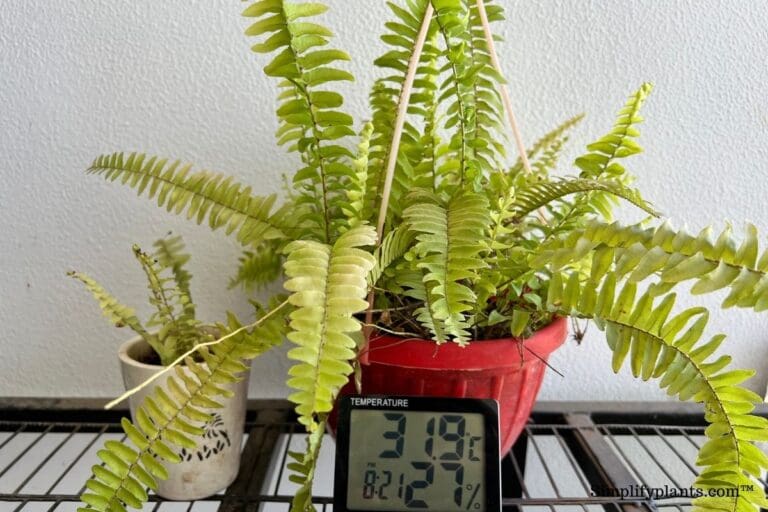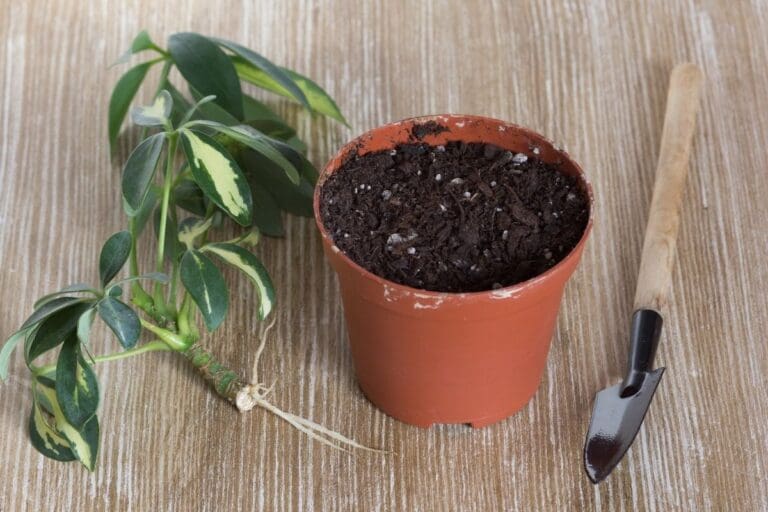Why Are My Croton Leaves Turning Brown? (Causes+How To Fix)
Croton is one of the most colorful houseplants because of its variegated leaves among all the houseplants. Maintaining an environment similar to their natural habitat is crucial otherwise the leaves of the plant will start turning brown.
In this article, we shall discuss why are your croton leaves turning brown and how you can fix the same.
Intense sunlight, insufficient watering, and low humidity are primary causes of the croton plant’s brown leaves. Brown spots might also appear due to sunburn or leaf spot disease. Examine the plant to determine the cause and maintain proper lighting and humidity to fix brown leaves.
Detailed knowledge of the problems helps a lot in fixing the brown leaves of Crotons. In this article, I have tried to map out the reasons and the cures of brown leaves on your Crotons.

Please note: Simplify Plants is reader-supported. Some links in the post are affiliate links and I get a commission from purchases made through links in the post.
Why are my croton leaves turning brown?
Too much heat and less moisture are the primary causes for leaves turning brown, but there are other causes.
Crotons come from a tropical area, thriving well in hot and humid places. Humidity and moisture prevent the plant from getting dehydrated. Dehydration can also make the leaves brown.
The reasons behind brown leaves on Crotons are briefly explained below.
Exposure to intense sunlight
An indoor Croton plant can receive excessive heat from either direct sun or chemical heat.
Croton grows healthy and shows its best colors when grown under full sun. But keeping them under the heat for too long can cause sunburn to the plant.
Chemical heat is the warm wind emitted from machines while they are in process.
The heat emitted from heaters and exhaust is unstable, and sometimes the air contains harmful chemicals. These chemicals are harmful to nature as well as the plant.
When a plant continuously receives too much heat, it further exceeds the volume of moisture stored in it.
The plant starts to vaporize out that moisture due to transpiration. Continuous moisture loss dries up the croton plant and makes the leaves brown.
Also read: What Kind Of Light Does A Croton Need? (Croton Light Requirements )
Underwatering the Croton plant

Dehydration is evil to croton plants since they love moist soil. If you are underwatering them, you are harming their appearance severely.
Through the xylem, water is carried onto different parts of the plant. Leaving your plant unwatered for days or even weeks kills the cells of the leaves.
Crotons prefer growing in moist soil, and they grow comfortably when the soil holds a good amount of moisture.
Underwatering reduces the flow of water around the plant. To accommodate the less water supply, plants utilize the already stored moisture.
This process of using the last bit of moisture can significantly dehydrate any plant; Croton is no exception. Watering at irregular intervals or not watering at all leads to underwatering.
Also read: How Often To Water Croton Plant? (Watering Schedule+Watering Problems)
Lack of Humidity

Croton leaves that become brown and brittle go through a lack of humidity. You should maintain a humidity range of 40-80% to retain the appearance of the multicolored leaves.
Especially during the winters, when the dry wind from heaters fills the already dry atmosphere, the humidity level falls. Due to less humidity and moisture in the surrounding, relative humidity decreases.
Humidity is indirectly proportional to the transpiration rate, i.e., the lesser the humidity, the higher the transpiration rate. If proper humidity is not maintained, the leaves turn brown due to a lack of moisture.
Also read: Do Crotons Need Misting? (+Maintaining Ideal Temperature)
Croton plant diseases

A croton plant can experience a lot of diseases and infections. It is unusual for a healthy plant to catch diseases, but unhealthy plants are prone to it. Among them, edema turns the leaves brown with blisters on them.
Overwatering in Crotons is responsible for edema. The plant tries to soak up excess water than its capacity; this leads to brown leaves with small blisters. Failure to identify and cure this disease can lead to a dull plant and losing all the leaves.
How to fix brown leaves on Croton?
We have mentioned the four most common reasons responsible for the leaves of your Croton turning brown. But don’t make these the only boundaries.
Remember, it’s never too late to mend something. You can always fix a plant (unless it is too late) by following some basic steps.
Fixing brown leaves on Croton due to:
Excessive heat

Croton generally is a plant with no issues if you keep it in full sun. Instead, it will grow brighter and more colorful.
So, why should the direct sun be a problem? It can become a problem because the sun has more energy in its rays during summer afternoons.
Transfer your plant’s pot into a relatively darker place, where it will receive less intense light. Try to avoid continuous exposure to scorching sun rays.
Don’t let your plant sit under the sun for too long. If you feel that the heat is too much and the leaves are wilting, it’s better to replace them.
Keep your plant away from household machines for damages due to heat emitted from machines.
Machines like refrigerators, air conditioners, and heaters emit warm air during their process. These machines make the environment too toxic and hot for a plant to survive.
The remedy is the same, and you have to avoid all the unnecessary heat by replacing your plant.
Also read: What Temperature Can Croton Tolerate? (+Ideal Temperature Range)
Underwatering
Watering issues are widespread. There are some ways by which houseplant owners can avoid underwatering.
Prepare schedules: You can create a chart and mark the date when you have watered your plants and the following dates. Crotons need a good amount of water to grow. Weekly watering is suitable for Crotons.
Water more often: Try to water your Croton according to its needs. Neither water it regularly nor neglect it.
Different varieties of crotons have different water requirements. Know the variety of your plant and water it accordingly.
Proper drainage

A pot with proper drainage holes and soil mix that holds moisture appropriately should be used. Pots with too many holes will drain out water fast and inappropriate soil mix that cannot hold and cause water loss.
Our regular soil mixed with perlite and peat moss is ideal for crotons. This soil mix recipe drains excess water from the soil and keeps enough water to keep the plant moist.
Crotons need their soil to be mildly acidic too, and one can also add some fertilizer to meet any loss of nutrients.
Before each watering session, make sure that your plant is ready for drinking. Make sure the topsoil is dry enough to accommodate more water.
Also read: What Kind Of Soil Does A Croton Need? (+Ideal Soil Mix & Requirements)
Maintaining humidity
For crotons, an ideal humidity ranges between 50-80%. Still, they can survive at 40%. Lack of humidity can happen due to temperature changes and a few other factors.
To restore humidity, keep your plant in a moist, humid place; the bathroom can be one of them.
You can also keep other moisture-loving houseplants together to maintain the humidity, place your plant near a humidifier or try a pebble tray.
Treating plant diseases
Plant diseases often turn the leaves of croton brown. Edema is one of them. It is not a very serious disease and is curable if identified at an early stage.
Steps to cure edema:
- Keep your Croton in a spacious and well-ventilated area.
- Use a pot with a proper drainage facility.
- Stop over-fertilizing our plant. Crotons are not fast-growing plants. Thus, over-fertilizing can have harsh effects.
- Avoid overwatering. It increases the chances of bacterial and fungal infections.
- If other plants are infected, keep them aside. Distance those plants from other plants that you have. Infections are contagious.
- And lastly, have patience and wait for your plant to cure itself and get its charm back.
How to revive a Croton with brown leaves?

In the above paragraph, we have thoroughly mentioned all the factors that cause brown leaves. Now it’s time to know how you can take steps to revive a croton plant with brown leaves.
The first step is to prune all the unnecessary brown damaged leaves. They will not grow back green, so it’s better to get rid of them. Pruning should be done with sharp scissors.
- Replace the plant with a place to get bright light, but not direct sun. Artificial lights are a great alternative.
- In case of under watering, drench the soil with water to make it wholly soggy and let it process all the water for a few days. It is vital to revive all the dry cells.
- But don’t water it for a few days or till the water is all processed and utilized, or else you will end up creating another mess.
- Mist and humidifiers are also effective in maintaining humidity.
- The pebble tray technique has also been adapted as a successful method of maintaining moisture. Take a tray (diameter should be a little larger than the pot), fill it with water, and add pebbles. Let the pot sit on the tray. This process will provide a continuous supply of water to the plant.
- Granulated fertilizers with an NPK ratio of 3:1:2 helps to restore their health. Mix some fertilizers in the soil while potting, or add some later.
- Never feed your plants during their dormancy period (end of fall and winter). Fertilizing once every month during their growing period is enough.
- Treat pests (if any). Use market-bought pesticides or homemade ones to treat pests. Take a spray bottle, fill it with a mixture of neem oil, mild liquid soap, and water. Spray it all over the plant. Repeat this until you get rid of them.
- And finally, take proper care of your croton plant. Don’t neglect it.
It might be difficult for croton plants to shape themselves according to their surroundings as a houseplant. To keep them colorful and healthy, we have to create the exact or somewhat similar environment to their native habitat around them.
Reference: Sciencedirect, Wikipedia, Wikipedia, Britannica, CABI, Academia, University of South Florida, The University of Georgia.
Recommended Garden Supplies
| Product Image | Our Recommended Gardening Supplies | Check Offers! |
|---|---|---|
Top Top
Top
Top
Top
Top
Top
Top
Top | rePotme Houseplant and Tropical Classic Potting Soil Mix | Check Offer On Amazon |
 Top
Top
Top
Top
Top
Top
Top
Top | Espoma Organic Indoor Plant Food | Check Offer On Amazon |
 Top
Top
Top
Top
Top
Top
Top
Top | GooingTop LED Grow Light 6000K Full Spectrum Clip Plant Growing Lamp | Check Offer On Amazon |
 Top
Top
Top
Top
Top
Top
Top
Top | Soil Moisture Meter | Check Offer On Amazon |
 Top
Top
Top
Top
Top
Top
Top
Top | Govee Hygrometer Thermometer, Bluetooth Enabled! | Check Offer On Amazon |
 Top
Top | LEVOIT Humidifiers for Large Room(Best For Plants) | Check Offer On Amazon |
 Top
Top
Top
Top
Top
Top
Top
Top | Upgraded DIY Automatic Drip Irrigation Kit, 15 Potted Houseplants Support | Check Offer On Amazon |
 Top
Top
Top
Top
Top
Top
Top
Top | Stainless Steel Heavy Duty Gardening Tool Set | Check Offer On Amazon |
 Top
Top
Top
Top
Top
Top
Top
Top | Bonide Insecticidal Soap | Check Offer On Amazon |
 Top
Top
Top
Top
Top
Top
Top
Top | Bonide 32 oz Spray Neem Oil for Organic Gardening | Check Offer On Amazon |
 Top
Top
Top
Top
Top
Top
Top
Top | Garden Safe Fungicide | Check Offer On Amazon |






